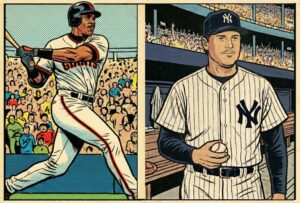The year 1886 proved to be a productive one for the state of Georgia.
In the “Peach State” on May 8, one of the most popular beverages in history was first concocted, and on December 18, a legendary ballplayer was born. As a result, Coca-Cola became a household name and one of the most profitable companies in the world, and Tyrus Raymond Cobb became a batting champion and eventually one of the first members of the National Baseball Hall of Fame.
The paths of these two American giants were linked, not only in their birth, but also in the first decades of the 20th century. Cobb, who was born in The Narrows, Georgia, made his major league debut for the Detroit Tigers on August 30, 1905. By that time, Coca-Cola was one of the most popular fountain drinks in the South. In September 1907, with Cobb’s Tigers on their way to their first American League flag, Coca-Cola began running an advertising campaign featuring the 20-year old ballplayer, who was on his way to the first of his record 12 batting titles. The ad showed the Georgian at the plate and claimed that Coca-Cola “will put you back into the game – relieve the thirst and cool you off.”
It was the first of many campaigns in which Cobb endorsed the soft drink. In part it read, “Ty Cobb says: I drink Coca-Cola regularly throughout all seasons of the year. On days when we are playing a double-header I always find that a drink of Coca-Cola between the games refreshes me to such an extent that I can start the second game feeling as if I had not been exercising at all, in spite of my exertions in the first.” Other ads in the Coca-Cola campaign featured future Hall of Fame members Nap Lajoie and Rube Waddell, among others.
Cobb Made Millions As Coca-Cola Investor
Cobb not only lent his image and name to Coca-Cola, he also invested his money. A shrewd businessman, Cobb bought his first stock in the Atlanta-based soft drink company in 1918 at the suggestion of friend Robert Woodruff, the son of the president of Coca-Cola and later himself the leader of the company for more than six decades. Cobb took out a loan against his future baseball earnings to buy his first 1,000 shares and continued to invest in Coca-Cola throughout his lifetime. Quickly, Cobb and Woodruff developed a close relationship, harbored by their common Georgian heritage – Woodruff a native of Atlanta. Like Cobb, Woodruff was a sportsman and an intense competitor, and he would often invite Cobb to go quail hunting on his 30,000 acre hunting plantation in Ichauway, Georgia.
Cobb’s Coca-Cola investments paid off handsomely, helping to make him one of the first athletes to become independently wealthy. In sharp contrast to other athletes who squandered their money and retired broke, Cobb built an enormous fortune over the course of his playing career and beyond. Confident in Coca-Cola, Cobb encouraged his friends and family to invest in the “Pause that Refreshes,” as well. Future Hall of Fame second baseman Charlie Gehringer, who debuted as a rookie with Detroit under Cobb’s leadership in 1924, recalled that Cobb would give the younger players financial advice. “He told us about Coca-Cola and egged us on to buy the stock, but we weren’t making enough money to buy shares,” Gehringer recalled years later.
One of baseball’s highest paid players, Cobb continued to put money into the company, later purchasing three Coca-Cola bottling plants, in Santa Maria, California, Twin Falls, Idaho and Bend, Oregon. Eventually he would own more than 20,000 shares of Coca-Cola stock, making him one of the major stockholders in the company and earning him a place on the board of directors. As the company grew, Cobb’s fortune swelled. At the time of his death in 1961, Cobb’s estimated worth was between $10 and $12 million, “a large volume of it generated by Coca-Cola stock,” according to Coca-Cola spokesman Phil Mooney. Due, in large part, to these investments, Cobb was able to establish the Cobb Educational Foundation of Atlanta, which paid college tuition for thousands of young people, and to build the Cobb Memorial Hospital of Royston, Georgia, just a few miles from his home town.
Cobb’s personality was a valuable commodity for Coca-Cola, even after his playing days ended. In 1947, the company released a set of cardboard posters, “All-Time Winners,” one of which featured Cobb, which introduced him to a new generation of baseball fans and soda drinkers. Other sports legends included in that series were boxer Gene Tunney, golfer Bobby Jones and football great Red Grange. In 1986, a special limited edition commemorative bottle with a photo of Cobb on the side was issued to celebrate the 100th anniversary of Cobb’s birth and the birth of Coca-Cola. The Hall of Fame has one of those bottles in its collections.







